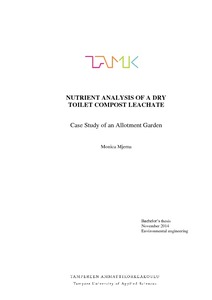Nutrient analysis of a dry toilet compost leachate : Case study of an allotment garden
Mjema, Monica (2015)
Mjema, Monica
Tampereen ammattikorkeakoulu
2015
All rights reserved
Julkaisun pysyvä osoite on
https://urn.fi/URN:NBN:fi:amk-2015052710589
https://urn.fi/URN:NBN:fi:amk-2015052710589
Tiivistelmä
The aim of this thesis was to examine the concentrations of the nutrients nitrogen, phos-phorus and potassium, as well as the amount of mixed liquor suspended solids in a sam-ple of dry toilet leachate. This thesis was done for the Global Dry Toilet Association of Finland (Käymäläseura Huussi Ry) and the leachate came from the dry toilets of the Nekala Allotment Garden in Tampere, Finland. The leachate had been stored for six months prior to analysis.
Total nitrogen was analysed using the total Kjehdahl method; potassium was analysed using flame photometry and phosphorus was analysed by spectrophotometry. The concentrations of the nutrients in the leachate were on average 1 628 mg/L for nitrogen, 6 mg/L for phosphorus and 62 mg/L for potassium. This means that the concentration for nitrogen was 19 times higher than that found in untreated domestic wastewater. The concentration for potassium was also higher than the concentrations found in untreated domestic wastewater, approximately 4 times higher. The phosphorus concentration in the leachate was within the range of phosphorus found in untreated domestic wastewater. Total suspended solids in the leachate were close to the amount found in untreated domestic wastewater at19 mg/L. The nitrogen concentration of the leachate was close to the lowest values of nitrogen concentrations found in urine, 1 790 mg/L, but very small compared to nitrogen concentrations in dry toilet compost, 14 600 mg/kg.
Since the leachate was six months old when the analysis was done, it is possible that there had been evaporation of water during the storage of the leachate, which could have increased the concentrations of the nutrients analysed. It is also possible that some of the chemicals remained attached to the canister and could not be analysed, and that sludge formation during storage could have affected the nutrient concentrations in it. Perhaps future analysis on more fresh leachate would yield different results.
Because the leachate is so nutrient rich, it will aid in the process of composting and hence it can be added to a composting pile. The amount of seep liquid to be added to the compost depends on the carbon concentration in the compost, since the composting process depends on the balance of carbon and nitrogen as well as sufficient amounts of moisture and air. The liquid could also be diluted and used as a garden fertilizer once it is old enough; the process takes from one to two years depending on the temperature it is kept at and how it is stored. The leachate cannot be used as fertilizer for consumer crops as this is prohibited by Finnish law, due to health risks associated with pathogens that could be in the leachate.
Total nitrogen was analysed using the total Kjehdahl method; potassium was analysed using flame photometry and phosphorus was analysed by spectrophotometry. The concentrations of the nutrients in the leachate were on average 1 628 mg/L for nitrogen, 6 mg/L for phosphorus and 62 mg/L for potassium. This means that the concentration for nitrogen was 19 times higher than that found in untreated domestic wastewater. The concentration for potassium was also higher than the concentrations found in untreated domestic wastewater, approximately 4 times higher. The phosphorus concentration in the leachate was within the range of phosphorus found in untreated domestic wastewater. Total suspended solids in the leachate were close to the amount found in untreated domestic wastewater at19 mg/L. The nitrogen concentration of the leachate was close to the lowest values of nitrogen concentrations found in urine, 1 790 mg/L, but very small compared to nitrogen concentrations in dry toilet compost, 14 600 mg/kg.
Since the leachate was six months old when the analysis was done, it is possible that there had been evaporation of water during the storage of the leachate, which could have increased the concentrations of the nutrients analysed. It is also possible that some of the chemicals remained attached to the canister and could not be analysed, and that sludge formation during storage could have affected the nutrient concentrations in it. Perhaps future analysis on more fresh leachate would yield different results.
Because the leachate is so nutrient rich, it will aid in the process of composting and hence it can be added to a composting pile. The amount of seep liquid to be added to the compost depends on the carbon concentration in the compost, since the composting process depends on the balance of carbon and nitrogen as well as sufficient amounts of moisture and air. The liquid could also be diluted and used as a garden fertilizer once it is old enough; the process takes from one to two years depending on the temperature it is kept at and how it is stored. The leachate cannot be used as fertilizer for consumer crops as this is prohibited by Finnish law, due to health risks associated with pathogens that could be in the leachate.
